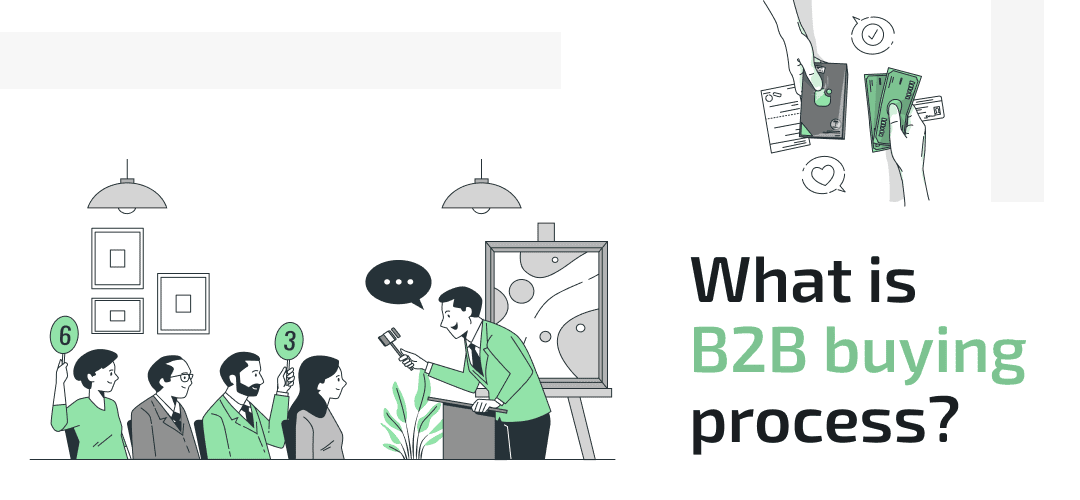
In the ever-growing world of online transactions, the B2B buying process is like a high-stakes chess game. Think of it as the ultimate strategic showdown, where companies flex their financial muscles to the tune of trillions of dollars. Yes, you heard that right — trillions each year! It's like Wall Street meets a global marketplace, minus the stockbrokers in fancy suits.
According to Forrester, U.S. B2B eСommerce will reach $3 trillion dollars by 2027, while offline B2B sales will likely remain flat. It’s only natural that successful B2B companies try easing pain points throughout the buying process and reaffirming their customers that they’re making the right decision. Sounds easy, but what’s the hitch?
In contrast to the relatively straightforward B2C customer journey, the B2B purchase process is typically intricate, extensive, and information-laden, with multiple stakeholders playing a role in purchasing decisions. As a result, it adheres to a formal procedure of convincing all the parties involved they will get a return on investment and only after that culminates in a final purchase.
This guide reveals the specifics of the B2B buying process, walks through its main stages, and gives useful advice on how to enhance it through flexible eCommerce platforms.
What is the B2B buying process (and how is it different from B2C)?
To add clarity to the matter, we should start with the B2B buying process definition. This is a systematic decision-making journey undertaken by companies when procuring products or services from other businesses. The process includes several stages, from problem recognition to careful consideration and final product selection.
The key differenсes between B2B and B2C buying experiences is the complexity and duration of decision-making. B2C customers typically make low-cost purchases for personal or household use at fixed prices.
In contrast, B2B buyers often purchase products in bulk and bear significant expenditures. However, they also have an opportunity to negotiate pricing and quoting in accordance with specific requirements and budgets. To mitigate possible risks and make an informed decision, multiple stakeholders get involved into the approval process.
Who are B2B decision makers?
The average B2B buying cycle involves 6-10 decision makers, each equipped with over four pieces of information that they have independently gathered. These can be both from inside or outside of the purchasing company.
At every stage of the B2B buying process, these individuals play one or more of the following roles:
- The initiator. The initiator is the one who kicks off the buying process. Usually it is a person from the organization capable of identifying problems or opportunities, and voicing their concerns to those in positions of authority.
- The gatekeeper. Gatekeepers serve as the primary point of contact when it comes to regulating the dissemination of information within an organization.
- The influencer. Whether they are internal or external, influencers possess the expertise and authority to influence the decision-making process. They can persuade buyers and decision-makers to make the purchase or talk them out of it.
- The decision maker. It can be the CEO, head of accounting, or business development manager who grants approval for an organization to proceed with a purchase.
- The buyer. This intermediary purchases the chosen solution. In the process, the person is responsible for meeting order minimums and negotiating wholesale price discounts.
- The end user. This is the key individual who will regularly use the new product. In some cases, it is the same person as the initiator. It is necessary to consider the user's needs and feedback during the purchasing process.
Keeping into account these roles is crucial for building an effective selling strategy and technical infrastructure that nudges all participants to finalize the purchase at each stage. Below are the main steps they would make on the way to the end product.
Essential steps in the B2B buying process
If the B2C buying process can be roughly narrowed down to “problem identification - research and evaluation - purchase”, the B2B buying process involves more steps that should be carefully considered before winning a customer.
Of course, all B2B businesses are different and revolve around different buying decisions, but the general process can be broken down into five stages (not necessarily following one another in the exact order given below as some steps can be reversed or even skipped).
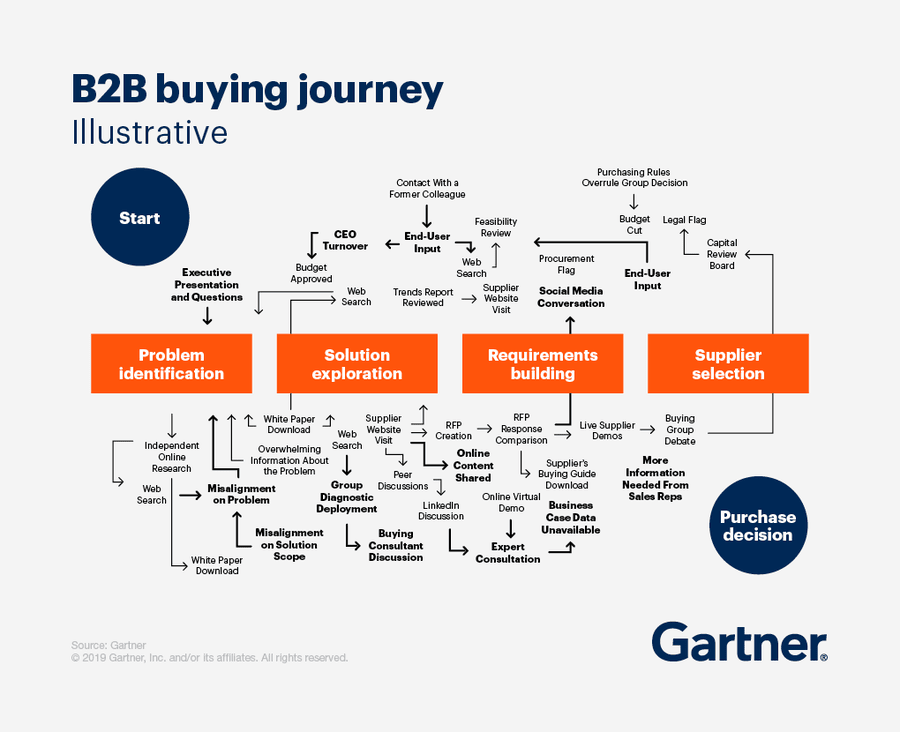
Step 1. Identifying challenges and needs
At this initial step, a business recognizes a gap or challenge within its operations. It could be anything from outdated technology to inefficient processes or the need for new products or services on the market.
Businesses often identify such pain points through various channels, including customer feedback, market research, and internal audits. Keep in mind that not all needs are apparent, and some may only surface through a thorough analysis of operations and market trends.
Step 2. Gathering information and researching
Once B2B buyers have identified an existing problem, the next stage is to explore a solution. At this point, initiators are unlikely to know the exact product(s) that will solve their problem. Thus, this phase also includes the process of gathering relevant data and insights, and defining requirements for the final product to be purchased.
The research process means looking for information online, seeking recommendations from colleagues, and attending industry events or conferences. The goal is to gather as much information as possible to form a comprehensive list of guidelines, i.e. specific features, functionalities, and performance expectations.
Step 3. Evaluating and selecting a vendor
After defining their requirements, businesses seek out potential vendors guided by recommendations from colleagues, online searches or industry networks. Vendors are evaluated based on their reputation, track record, and alignment with the defined requirements.
In many cases, B2B buyers issue Requests for Proposal (RFPs) or Quotation (RFQs) to shortlisted vendors, asking for detailed information and pricing proposals. Upon receiving the quote, they assess factors such as cost, quality, delivery timelines, and the ability to meet their unique needs. To finalize terms and pricing, this stage may involve legal and procurement teams.
Step 4. Making an informed decision
Choosing the right vendor isn’t the final step in the B2B buying process, it’s also necessary to convince all the stakeholders involved that you’ve found the best candidate. And the bigger the company, the more challenging it can become. Legal and procurement teams often play a crucial role at this stage.
This phase can be quite protracted since it requires aligning diverse opinions and priorities. But after a vendor is finally selected, a formal purchase order is issued. This document solidifies the agreement, specifies terms, and initiates the real procurement process.
Step 5. Purchasing and starting to use
It is the final stage of the buying process in the B2B market. Following the purchase order, the vendor delivers the product or service, and implementation begins. Close collaboration between the buyer and vendor ensures a smooth transition, minimizing disruptions to the buyer’s operations.
After implementation, the buyer evaluates the vendor’s performance and the effectiveness of the solution. Successful B2B transactions often lead to long-term relationships in order to address ongoing needs, explore additional opportunities for collaboration, and build trust.
These steps schematically represent the whole B2B purchase process and highlight the possible challenges at each stage of the customer lifecycle. To win in this game, many businesses, including eCommerce, should introduce innovations and use technical advancements to speed up the process. What are these new technologies? Read on to find out.
Tips to improve the B2B purchase process in eCommerce
From streamlining procurement workflows to making data-driven adjustments, modern B2B eCommerce businesses put a lot of effort into ensuring that the B2B purchase decision process on their websites is clear and seamless.
To facilitate the previously discussed stages, it is crucial to implement new technologies and specific eCommerce features. While some of them can be added in a few clicks and are quite popular among the business sector, the others can require considerable investment and creativity. Yet, we’ve compiled both groups so you can improve your B2B buying process at the current stage and plan bigger enhancements.
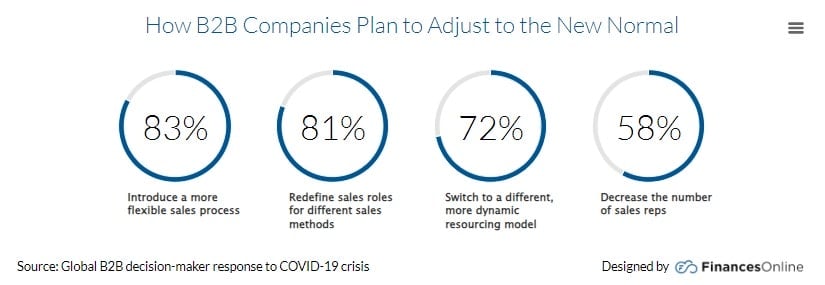
Streamline business processes
Before placing an order, business buyers evaluate products and suppliers, and even the smallest hiccups in your transactional processes can have a big impact on their satisfaction rates. The easiest and probably the smartest way is to smoothen existing features and steps in the buying process, especially those connected to money.
For example, offering individualized pricing options based on order volume, loyalty, or negotiated terms can make a substantial difference since one size does not fit all in the B2B world. Access to tiered pricing or personalized quotes can strengthen customer relationships and encourage repeat business.
The ability to choose from a range of payment methods can also reduce friction in the purchasing process. Alongside traditional methods like credit cards and invoices, consider incorporating digital wallets, ACH transfers, or payment gateways. Flexible payment terms, like net terms or installment plans, can improve cash flow management.
It’s also recommended to allow customers to customize their shipping preferences, delivery timelines and carrier choices. Moreover, offering bulk or consolidated shipping options for large orders can help businesses save on logistics costs.
Incorporate the best features of self-service portal
According to the latest B2B sales reports, B2B buyers spend about 85% of their time researching potential suppliers and products they offer. Consequently, most customers expect a direct-to-consumer (DTC) experience, including seamless checkout, effortless product discovery and transparent returns policy.
A self-service portal allows users to access and manage password-protected information, perform tasks, and complete wholesale eCommerce transactions independently, without a sales representative assigned to their business entity.
Creating a business account, B2B buyers can view wholesale price lists, set custom payment terms, generate invoices for previous orders, and add other decision makers to the company profile – all this significantly facilitates the purchase process.
Expand web presence to more channels
A strong online presence is no longer a whim but a necessity for B2B businesses. Their corporate website should contain precise information on the company’s mission and goals, current initiatives, operational and transactional processes, the effectiveness of products or services.
It’s not sufficient to maintain a mere presence on different social media platforms like LinkedIn, Facebook and Instagram, it is now imperative to use these channels effectively to deliver value to the target audience. This means the omnichannel approach to e-business.
Selling through such B2B marketplaces like Amazon or Alibaba is more convenient and cheaper than launching a full-fledged website. It is a perfect wayout for emerging businesses that don’t have enough budgets or a great addition for well-established enterprises. Marketplace users can save products to their wish lists, compare product specifications and evaluate pricing within a singular website tab.
Personalize B2B marketing campaigns
The B2B buyer statistics by Gartner shows that customers who were provided with valuable information by suppliers during their decision-making process were 2.8 times more likely to experience convenience in their purchase. Additionally, these customers had a threefold increase in the likelihood of placing a larger order.
Buyer enablement is a strategic approach that focuses on addressing the specific needs and pain points of B2B buyers in order to facilitate confident decision-making. As part of this strategy, it is recommended to share social proof, such as case studies and testimonials from previous buyers who have successfully resolved the same problem. White papers also serve as informative resources that further establish some product(s) as a viable solution.
Furthermore, hosting webinars that feature interviews with industry experts can greatly influence the B2B buying process. These experts can act as influential figures, providing valuable insights and guidance to potential buyers.
Keep in mind the post-purchase service
The B2B purchasing process extends beyond the initial order placement as enduring relationships with customers significantly increase the likelihood of repeat orders. Given the nature of their offerings, B2B companies have a more limited customer base but their clients often buy the same or similar products on a recurring basis.
Ensure that customer support is readily available for first-time buyers. Take a proactive approach by providing valuable advice (incl. effective marketing campaigns, emerging trends, or innovative product display concepts) to retailers, facilitating the reselling of your products.
Remind buyers of their purchased items and encourage them to invite colleagues to explore the company’s profile. Anyone within the organization should be able to access and review past orders, as well as repurchase the same inventory (given they possess the appropriate permission level). This seamless process empowers them to swiftly validate and approve new purchases.
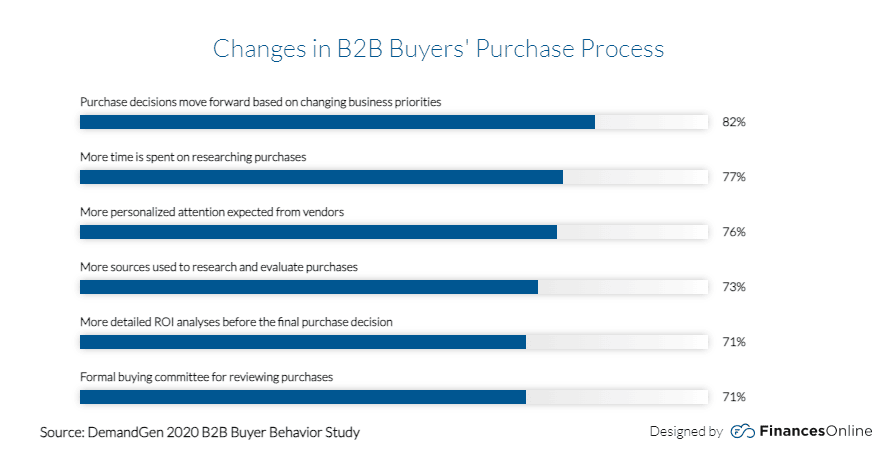
How B2B businesses are using technology to enhance their buying process: 3 case studies
To implement these tips into your online business, you should have a powerful B2B eCommerce platform that supports robust built-in features and provides sufficient customization options. And nopCommerce is one of such universal yet extremely flexible solutions.
Here are the essential functions you should look for in the chosen eCommerce software to build the best B2B buying journey for your customers and keep them coming back.
- Customization. eCommerce platforms should be flexible and scalable to easily adapt and expand alongside the specific needs of businesses. For example, the open source code can be effortlessly modified to improve security, while also introducing exciting new features. It is obvious that the demand for personalization is on the rise, especially with the emergence of such cutting-edge technologies like headless commerce.
- Advanced search and filtering. This feature not only simplifies the shopping experience for B2B buyers but also helps them make informed decisions efficiently. Robust search and filtering options allow to quickly locate products based on criteria like SKU, category, price range, or availability.
- Personalized user accounts. Personalized user accounts for B2B customers allow to save order history, favorite products, and shipping preferences, which streamlines the ordering process for repeat purchases. Access Control Lists are also used to determine access to critical data. Each user is assigned a specific role and a range of permissions that empower or restrict their actions.
- Streamlined buying process. By offering features like one-click reordering, saved payment methods, and address auto-fill, buyers are empowered to swiftly move from product selection to payment confirmation. B2B transactions often require detailed documentation, and providing the ability to generate and download invoices directly from the checkout page is invaluable.
- Custom pricing and quoting. B2B transactions often involve negotiation. With custom quoting, buyers can initiate and streamline negotiations through the platform, reducing the need for extensive back-and-forth communication.
- Real-time inventory management. It is necessary to keep inventory levels updated in real-time to prevent overselling or backorders. For these purposes, integration with third-party inventory management systems is crucial for accuracy. As a result, customers can confidently place orders, knowing they'll receive what they've paid for in the expected timeframe.
- Mobile optimization. B2B mobile eCommerce facilitates seamless transactions between businesses on smartphones and tablets. Through a mobile-responsive website, vendors and suppliers can effortlessly engage with their customers, starting their communication on one device and then completing an order on another. A strong mobile presence also impacts SEO rankings.
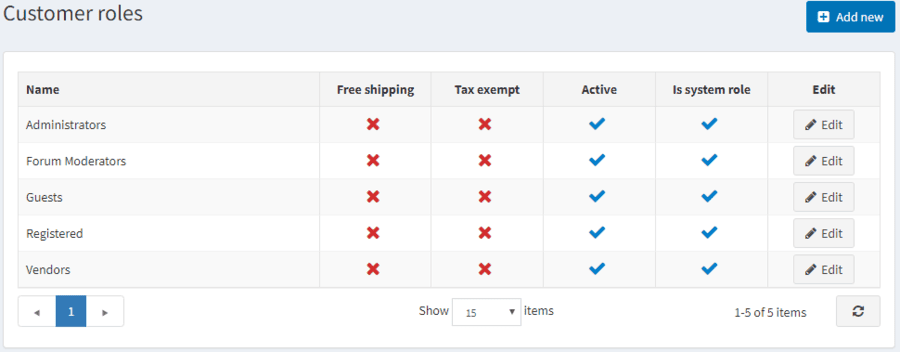
Keeping in mind these must-have features, we still need to say that the key to a great B2B website is not in staffing it with the latest technologies just for the sake of it, but in having all the fundamentals in place and then creating a unique brand voice.
Below we’ve gathered a few B2B buying process examples of nopCommerce-powered websites to show you how eCommerce companies streamline the buying journey and customer service.
Aveva: give clear value propositions
Aveva is a multinational company that provides software solutions and services for various industries, including oil and gas, energy, manufacturing, and infrastructure. The company’s offerings cover engineering and design, asset performance management, and industrial information management, helping businesses across the world achieve operational excellence and innovation.

Their website has a great structure, informing visitors about the products they offer, guiding them along the pages using catchy headlines, further educating them through demo videos and enhanced visuals, and offering lead magnet CTAs to finalize the deal. Using nopCommerce’s customization options, Aveva divided its website into several sections for different types of customers, creating full-fledged sub-portals for each of them.
TRC Electronics: negotiate pricing & quotes
As a distinguished franchised distributor, TRC Electronics specializes solely in power supply products. Their mission is to make a positive impact on clients and team members, both personally and professionally, while also contributing to their financial success.
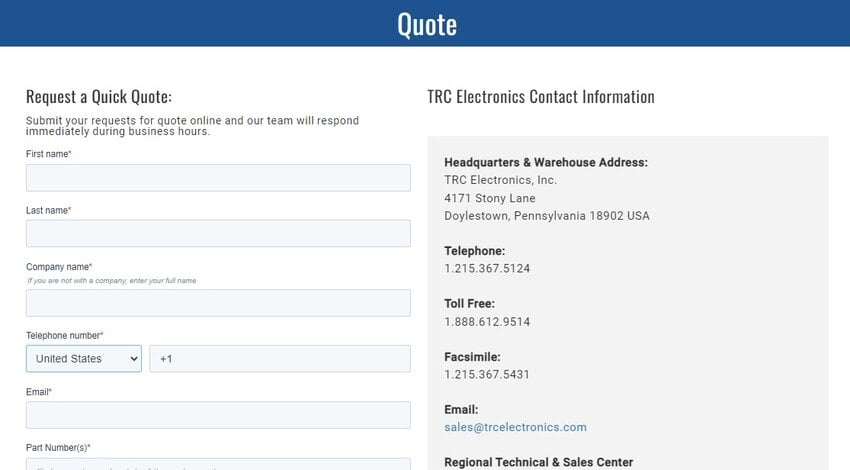
The company utilized nopCommerce to create an extended product catalog, allowing to feature detailed information about each item and filtering through possible options. The website truly benefits from the omnichannel approach, supporting both office and online sales. The best part is the ability to request a quote and negotiate pricing (which is essential for B2B buyers) via the website, without the need to interrupt the B2B purchase process and switch to some other channel.
Greenheck: make navigation smooth & easy
Greenheck is a leading U.S. manufacturer of air movement and control equipment. The company specializes in a wide range of ventilation products, including fans, dampers, louvers, kitchen ventilation systems, and energy recovery units. With a reputation for high-quality and innovative solutions, Greenheck plays a vital role in equipping commercial buildings, hospitals, industrial facilities, and residential spaces.
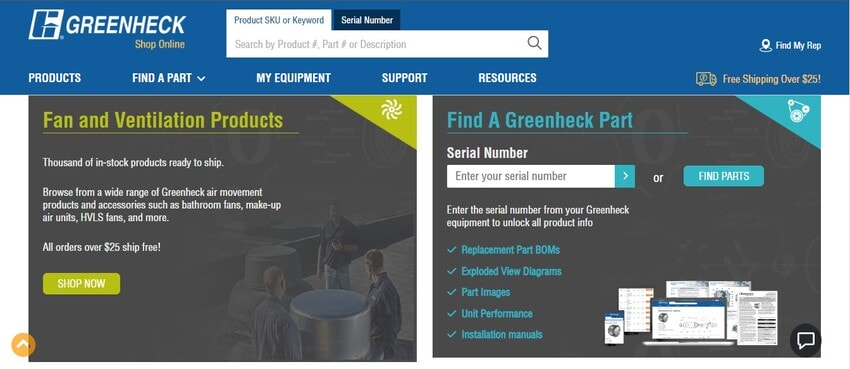
With nopCommerce, the company rolled out a website that is robust enough to handle orders across different time zones, languages, and currencies. It allows customers to search for both fan and ventilation products and parts for them. The search can be done either through an extensive catalog or serial number. Once the necessary product is found, the website instantly offers related items and additional services, which increases the number of upsells and encourages buyers to place bulk orders.
Craving for more educational examples? Check out the best B2B eCommerce websites and learn how to recreate their powerful functionality with nopCommerce.
Final thoughts
As you can see, the B2B buying process may be lengthy, but it is no longer as complicated as pre-pandemic times when in-person meetings were necessary before finalizing any B2B order. That’s the good news. The biggest challenge is that B2B buyers now seek B2C-like experiences, and tend to choose eCommerce platforms that are capable of building an easy and attractive front-end, combined with a feature-rich and flexible back-end.
With nopCommerce, businesses have the opportunity to not only streamline the B2B purchase process, but also enhance the customer experience by providing smoother and more personalized transactions, improving operational efficiency, minimizing errors, and ultimately fostering growth within the B2B eCommerce sector.